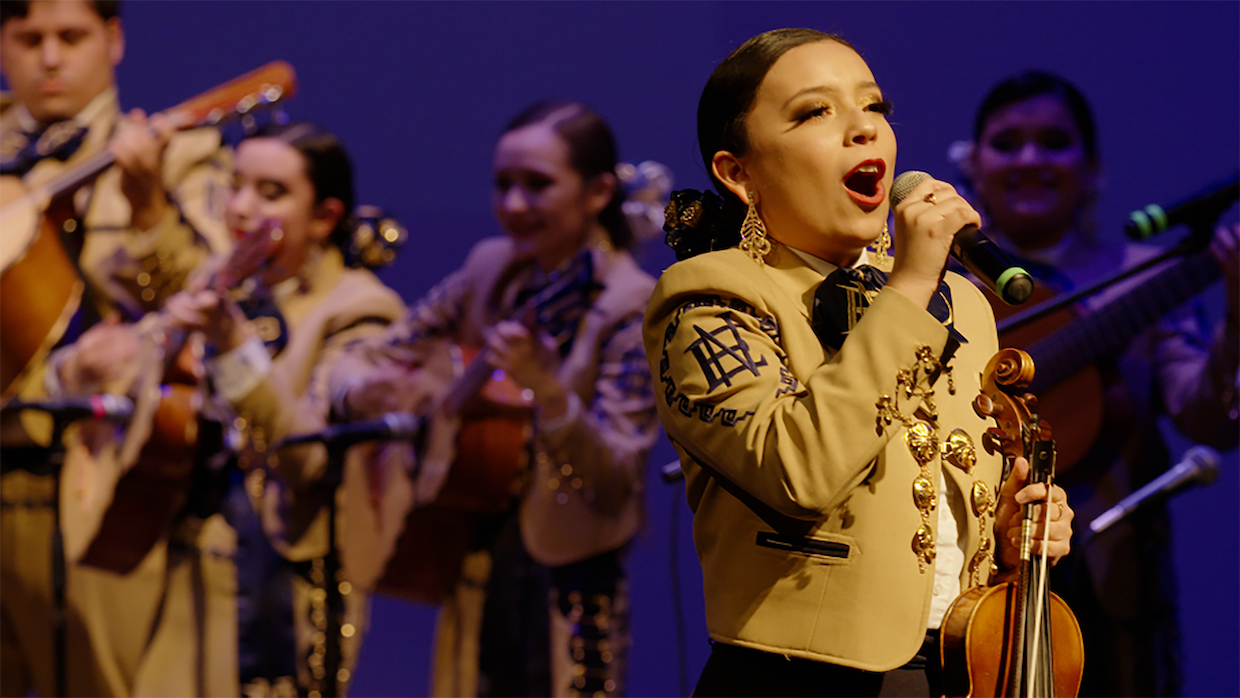 Back to selection
Back to selection
“Our Cinematography Hopefully Emphasizes the Elegance of Mariachi”: DP Michael Crommett on Going Varsity in Mariachi
 Going Varsity in Mariachi.
Going Varsity in Mariachi. Competitive scholastic mariachi in South Texas is the subject of Going Varsity in Mariachi, the documentary from filmmakers Alejandra Vasquez and Sam Osborn. Specifically, the focus is on Edinburg North High School’s Mariachi Oro team, featuring passionate coach coach Abel Acuña, driven team captains Abby, Marlena, and Bella as well as the vibrant music produced by the entire team.
DP Michael Crommett discusses lensing the project, including how his past documentary work aided him on this shoot.
See all responses to our annual Sundance cinematographer interviews here.
Filmmaker: How and why did you wind up being the cinematographer of your film? What were the factors and attributes that led to your being hired for this job?
Crommett: The directors, Alejandra and Sam, secured an emerging filmmakers grant from Osmosis Films, and it was my luck that a longtime collaborator and friend, Rachel Mills, worked at Osmosis and put my name forward. My previous work with Rachel along with my experience filming high school basketball in the Navajo Nation and baseball in Japan demonstrated my documentary experience particularly with teenagers. After an initial Zoom meeting, we did a preliminary shoot where I imagine Alejandra, Sam, and the producers decided I was good enough to get the gig.
Filmmaker: What were your artistic goals on this film, and how did you realize them? How did you want your cinematography to enhance the film’s storytelling and treatment of its characters?
Crommett: First and foremost I wanted to facilitate Alejandra and Sam’s desire to portray high school mariachi in a way that the teachers and students would appreciate and recognize. We accomplished this by always listening to our contributors and respecting their boundaries. This involved time spent with the camera switched off, allowing everyone to know each other without capturing footage. I also wanted to enhance the pride and beauty of mariachi by shooting low angles when possible, lending the students increased gravitas. Our cinematography hopefully emphasizes the elegance of mariachi, as some people see it as low-quality and look down on musicians playing “al talon.” That elegance is on display in a sequence showing the costureras dedication to making high quality trajes de charro for the team. It is also shown in the young women’s dedication to their hair and makeup. We also chose to shoot on long lenses and on tripods and Dana Dolly for the classroom scenes to give them a more controlled feel.
Filmmaker: Were there any specific influences on your cinematography, whether they be other films, or visual art, of photography, or something else?
Crommett: Texas Monthly’s photography is a huge influence. The way they emphasize both people and landscape is inspiring. We all love the film Rich Hill, and we definitely referenced that a lot.
Filmmaker: What were the biggest challenges posed by production to those goals?
Crommett: By locking down the cameras in the classroom, it definitely presents limitations in terms of coverage. Once you’ve planted sticks and a moment occurs, you have to capture it from your position.
Also as with all documentaries, having the necessary resources at the correct times is one of the biggest challenges. But the beauty of doc is that however you capture the moment, the audience will accept the limitations.
Filmmaker: What camera did you shoot on? Why did you choose the camera that you did? What lenses did you use?
Crommett: Sony FX9 with Angenieux EZ Zooms and Sony FX6 with Sigma Zooms. The mariachi rehearsals occur in typical cinder block, fluorescent lit classrooms, and though we wanted to be true to that environment in our wide shots, the large sensor of the FX9 helped isolate the students and remain connected to their experience within that environment. The other benefit of large sensors is they allow longer lenses to have a wider field of view. This mimics the narrow focus but wide range of vision of the human eye. This places the viewer squarely in the students’ experience whether in the classroom, at home, or in the wings right before their competitions. Additionally the Sony color science is very flexible, allowing us to shoot in a wide variety of lighting environments, and the built in variable ND made it easy to keep a consistent f-stop throughout the project.
Filmmaker: Describe your approach to lighting.
Crommett: There was minimal additional lighting in the project. We lit our interviews and our student portraits. The philosophy of the interviews was to be as subtle and natural as possible. We want the audience both in the lighting and framing to believe they could have been shot on the fly, so they integrate with the verite as seamlessly as possible. The goal with the portraits was much more about elegance and beauty.
Filmmaker: What was the most difficult scene to realize and why? And how did you do it?
Crommett: The two final performances, which are mixed together in the final film, were certainly the most challenging. They involved multiple cameras with various operators including one of the directors, and I had to be following teams shooting handheld verite. Therefore, I nor the directors could be at a monitor with a comms headset directing cameras.
Filmmaker: Finally, describe the finishing of the film. How much of your look was “baked in” versus realized in the DI?
Crommett: We shot in S-Log3 with a neutral LUT I developed. We then formed the look in the DI with our colorist Sam Gursky.
TECH BOX
Film Title: Going Varsity in Mariachi
Camera: Sony FX9 and FX6
Lenses: Angenieux EZ Zooms and Sigma Zooms
Lighting: Aputure 600D, Aladdin Bi-Flex 2, Astera Titan and Helios Tubes
Processing: N/A
Color Grading: Davinci Resolve
